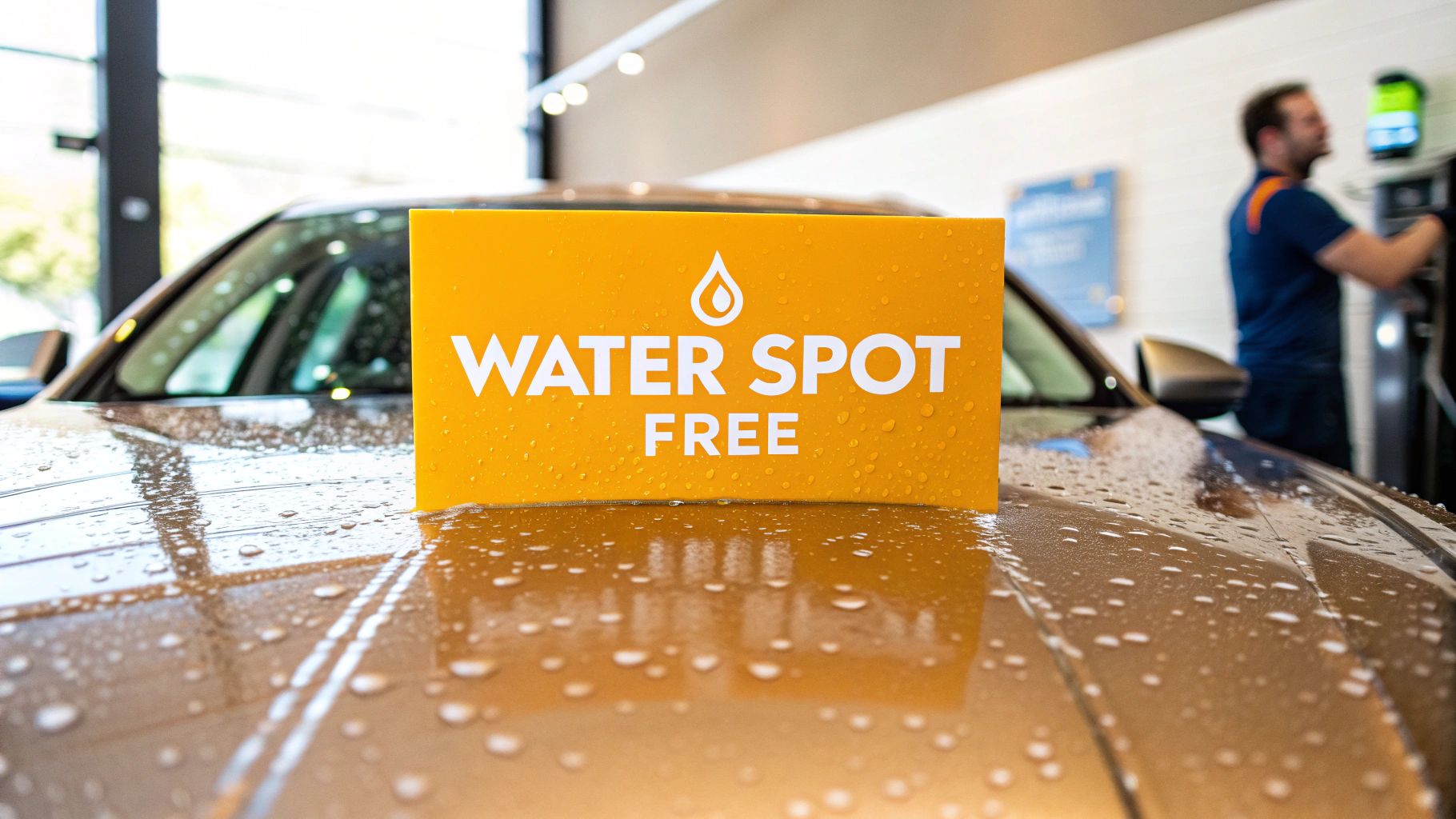Why Water Spots Ruin Your Perfect Shine
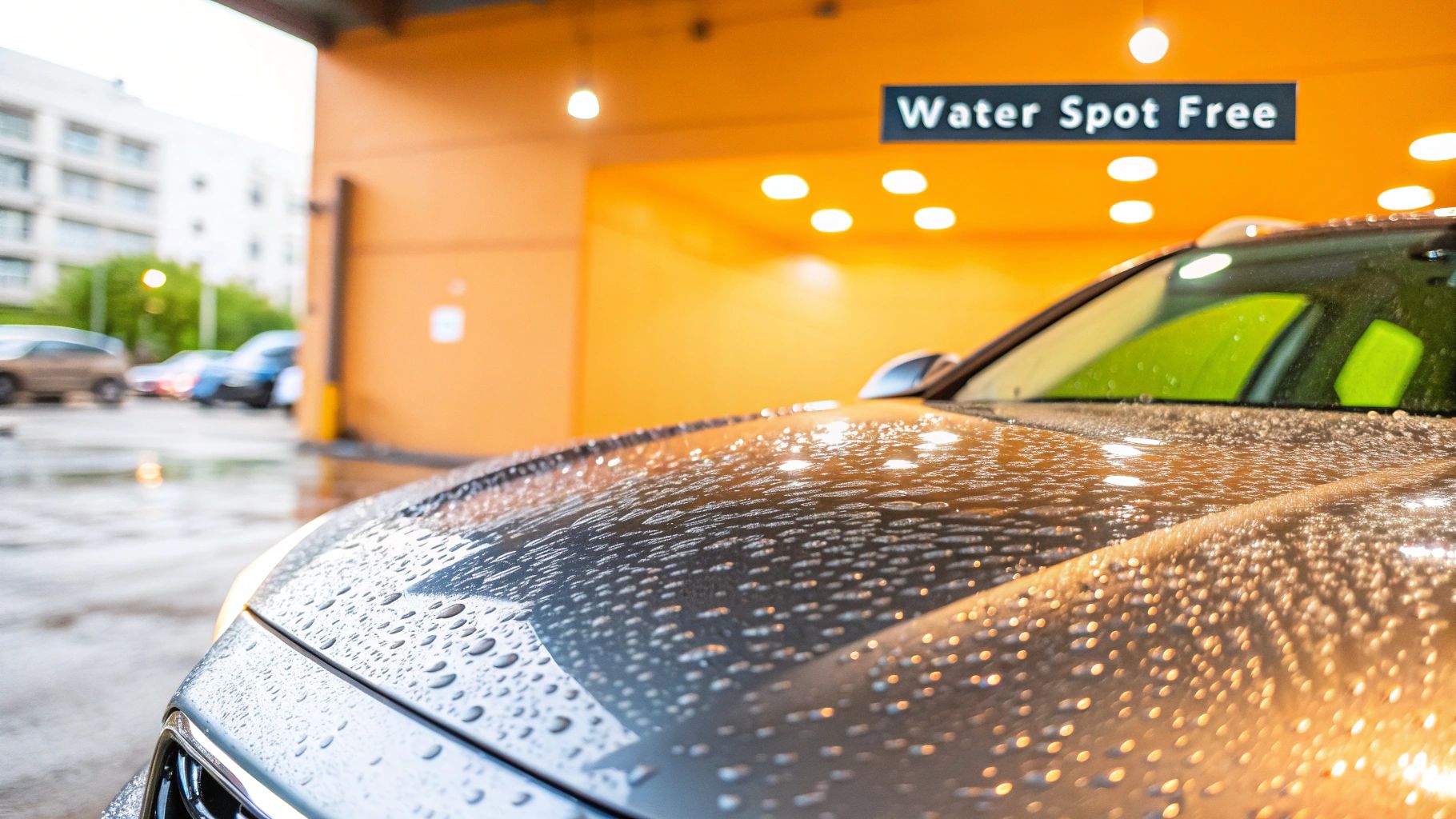
That freshly washed car, sparkling under the sun, is a satisfying sight. But this quickly fades when water spots appear. These spots aren’t just an eyesore; they can damage your car's paint. Tap water contains dissolved minerals. When water evaporates on your car, these minerals are left behind, forming water spots.
This is similar to leaving a glass of tap water out overnight. You'll see a ring of residue. The same thing happens on your car, only magnified. This residue, often calcium and magnesium, forms temporary water spots.
If ignored, these can become etched into the paint. The minerals react with the clear coat, causing permanent damage. Like etching glass, it's difficult to restore the original condition. These etched spots dull the shine and lower resale value.
Traditional washing often worsens the issue. Rinsing and air drying practically guarantees water spots. The minerals spread and dry in place. A spot-free car wash needs a strategic approach. We must understand the science behind these spots.
The Rise of Automatic Car Washes
This shift toward high-quality cleaning shows in the automatic car wash market growth. In 2025, it reached USD 2.82 billion, thanks to advancements in sensor technology and robotics. This is expected to hit USD 4.66 billion by 2030. You can find more statistics in this Automatic Car Wash Market Report. This growth highlights protecting vehicle integrity and customer satisfaction.
Proper car maintenance is crucial for your car’s longevity. Check out these helpful Car Maintenance Tips. Understanding water spots is the first step to prevention and a flawless finish.
Essential Tools for Guaranteed Spot-Free Results
Achieving a truly spot-free car wash involves more than just soap and water. It requires the right tools. Investing in quality equipment is essential to preventing those frustrating mineral deposits. This section explores the key tools that will deliver professional-level results and transform your car washing routine.
Water Filtration: The Foundation of Spot-Free Washing
The first step in preventing water spots is filtering the water itself. This removes minerals before they come into contact with your car's finish. There are various filtration options available to suit different budgets and needs. A simple hose attachment filter is a cost-effective starting point, offering basic filtration for mildly hard water.
For areas with significantly hard water, a deionization (DI) system offers a more thorough solution. DI systems utilize resin beads to extract nearly all minerals, producing pure water for a flawless finish. This investment can be particularly valuable in areas with hard water, guaranteeing a spot-free shine.
Drying Tools: More Than Just Wiping
Properly drying your car is just as important as the washing process itself. A premium microfiber drying towel is a must-have. Look for towels with a high GSM (grams per square meter) rating, as this indicates superior absorbency. However, even the best towel won’t prevent water spots if used incorrectly.
The key is to blot, not wipe. Wiping can drag minerals across the paint, potentially scratching the surface and increasing the chance of spots. Blotting, on the other hand, lifts the water away, leaving a clean, spot-free surface.
In addition to a quality towel, consider using a drying aid, often referred to as a quick detailer. These products help sheet water off the car, further minimizing drying time and the potential for water spots. They also provide a layer of gloss and protection to enhance your car's shine.
Other Helpful Tools for a Spotless Shine
Beyond the core essentials, a few other tools can enhance your spot-free car wash. A foam cannon, such as the SwiftJet Car Wash Foam Gun, elevates the pre-wash stage by lifting dirt and grime without harsh scrubbing. This reduces the risk of scratching during the wash itself. Using multiple wash buckets, one for soapy water and one for rinsing your wash mitt, minimizes cross-contamination, preventing minerals and dirt from being reapplied to the car.
The following table summarizes the essential tools for achieving a spot-free finish and compares their effectiveness, ease of use, and cost:
Water Spot Prevention Tools Comparison: This table compares essential equipment for achieving a water spot free car wash, with ratings for effectiveness, ease of use, and cost.
| Equipment Type | Effectiveness Rating | Ease of Use | Initial Cost | Maintenance Cost | Best For |
|---|---|---|---|---|---|
| Hose Attachment Filter | Low | High | $15 - $50 | Low (filter replacements) | Light water hardness, budget-conscious |
| Deionization (DI) System | High | Medium | $100 - $300 | Medium (resin replacements) | Moderate to high water hardness, serious detailing |
| Microfiber Drying Towel | Medium | High | $10 - $30 | Low (washing) | All car washes |
| Drying Aid/Quick Detailer | Medium | High | $10 - $20 | Low (replenishing product) | Enhancing shine, reducing drying time |
| Foam Cannon | High | Medium | $30 - $100 | Low (cleaning) | Pre-wash, minimizing scratching |
| Multiple Wash Buckets | Medium | High | $10 - $20 | Low (cleaning) | Minimizing cross-contamination |
This table highlights the trade-offs between cost and effectiveness. While a simple hose filter is affordable and easy to use, it's less effective than a DI system for heavily mineralized water. Similarly, microfiber towels and drying aids offer convenient spot prevention, but proper technique remains crucial. Investing in multiple buckets and a foam cannon further elevates the washing process, reducing the risk of scratches and contamination.
By investing in these tools and utilizing them correctly, you'll be well-equipped to consistently achieve a water spot-free car wash. This protects your car's finish and preserves its shine for years to come.
The Perfect Spot-Free Washing Method Anyone Can Master
Achieving a spot-free car wash isn't some magical feat, it's a science. Understanding how those pesky water spots form empowers us to prevent them. This guide breaks down the perfect washing and drying method, so you can achieve professional results right at home. We'll focus on minimizing mineral contact and quick drying, the two keys to a spot-free shine.
Pre-Wash Preparation: Setting the Stage for Success
Before even thinking about soap, a thorough pre-wash is crucial. This removes loose dirt and contaminants that can scratch your paint during the wash. Use a foam cannon or pre-wash spray to coat your vehicle. Let it dwell for a few minutes to loosen the grime. This pre-wash drastically reduces the need for scrubbing later, minimizing swirls and scratches. It essentially creates a clean slate for the main wash, ensuring a more effective and spot-free result.
The Two-Bucket Wash: A Professional's Secret
The two-bucket method is a detailing staple and vital for spot-free results. One bucket holds your wash solution, the other contains clean rinse water. After each pass over your car, rinse your wash mitt in the rinse bucket before getting more soapy water. This simple trick prevents dirt and minerals from transferring back to your car, reducing scratches and water spots. It's a controlled cleaning process, ensuring every inch is washed with fresh solution.
Drying: The Final and Most Crucial Step
Drying is where most water spots appear. After rinsing your car, immediately dry with a high-quality microfiber drying towel. Blot, don't wipe, to lift water away. Wiping can spread minerals, leading to spots. For extra shine and faster drying, use a drying aid or quick detailer to help sheet water off quickly.
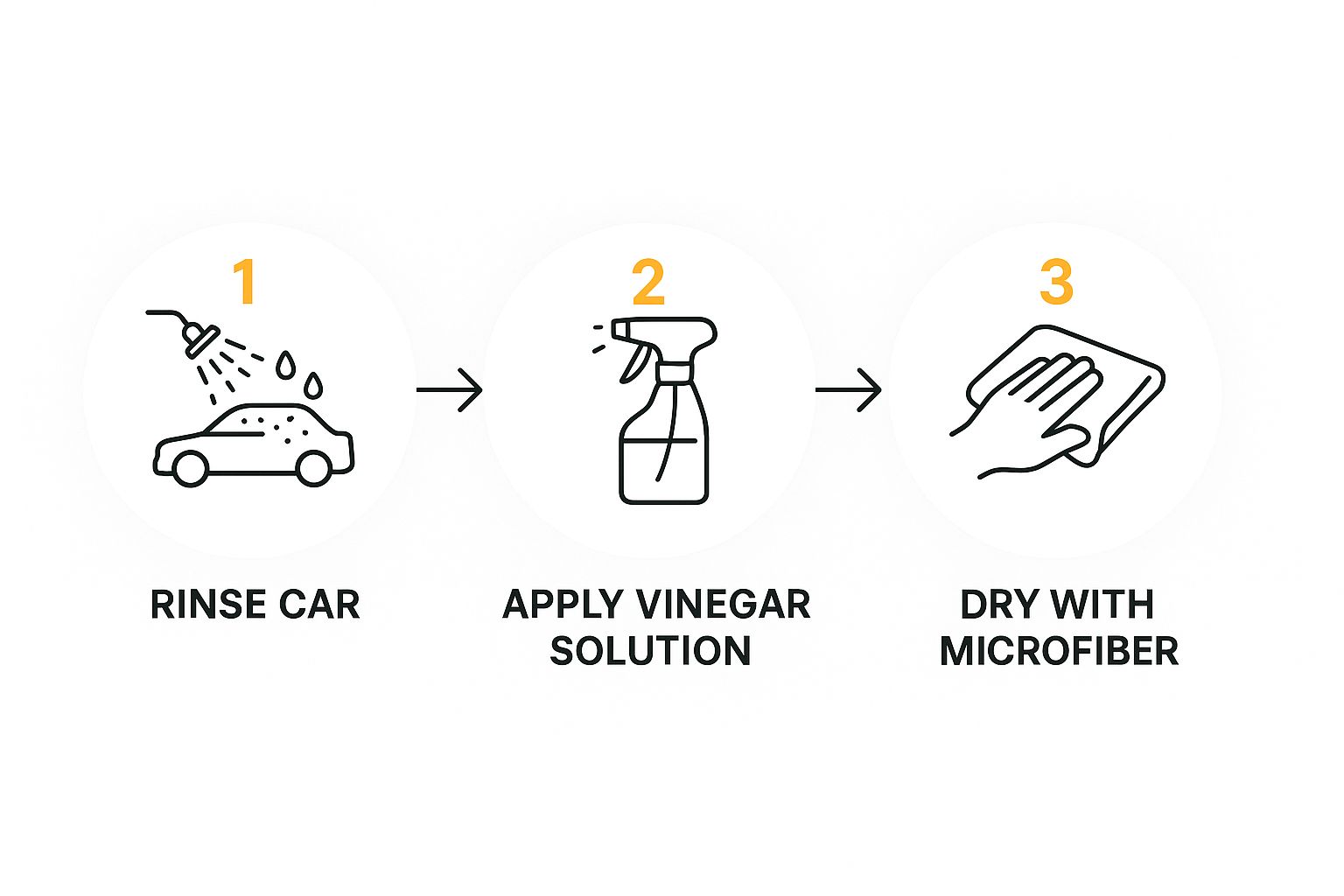
The infographic above illustrates a simple three-step process for removing existing water spots: rinse, apply a vinegar solution, and dry. These steps, done carefully, offer a practical solution for minor water spots, emphasizing the importance of rinsing and thorough drying.
Tackling Tricky Areas: Don't Let Water Hide
Pay close attention to areas where water lingers: door jambs, emblems, and mirrors. Use a dedicated microfiber towel or a drying aid to dry these spots completely. These hidden areas can become breeding grounds for water spots if neglected. Taking the extra time to dry them ensures a uniformly spotless finish.
Seasonal Adjustments: Adapting to the Elements
Your washing and drying techniques should adapt to the season. In winter, avoid washing in direct sunlight to prevent freezing. During summer, wash in the shade or early morning to minimize rapid evaporation. These adjustments ensure consistent, spot-free results year-round.
The global car wash service market is booming, showing increased demand for professional-level washes. Valued at USD 34.31 billion in 2024, the market is expected to grow at a CAGR of 6.2% from 2025 to 2030. This growth is fueled by factors like the preference for professional services – over 77% of North American and Western European drivers choose professional car washes. Learn more here. This trend underscores the importance of spot prevention in meeting customer expectations for a truly clean car. Mastering these techniques not only protects your car's finish but also enhances its long-term value.
Finding Professional Services That Truly Deliver
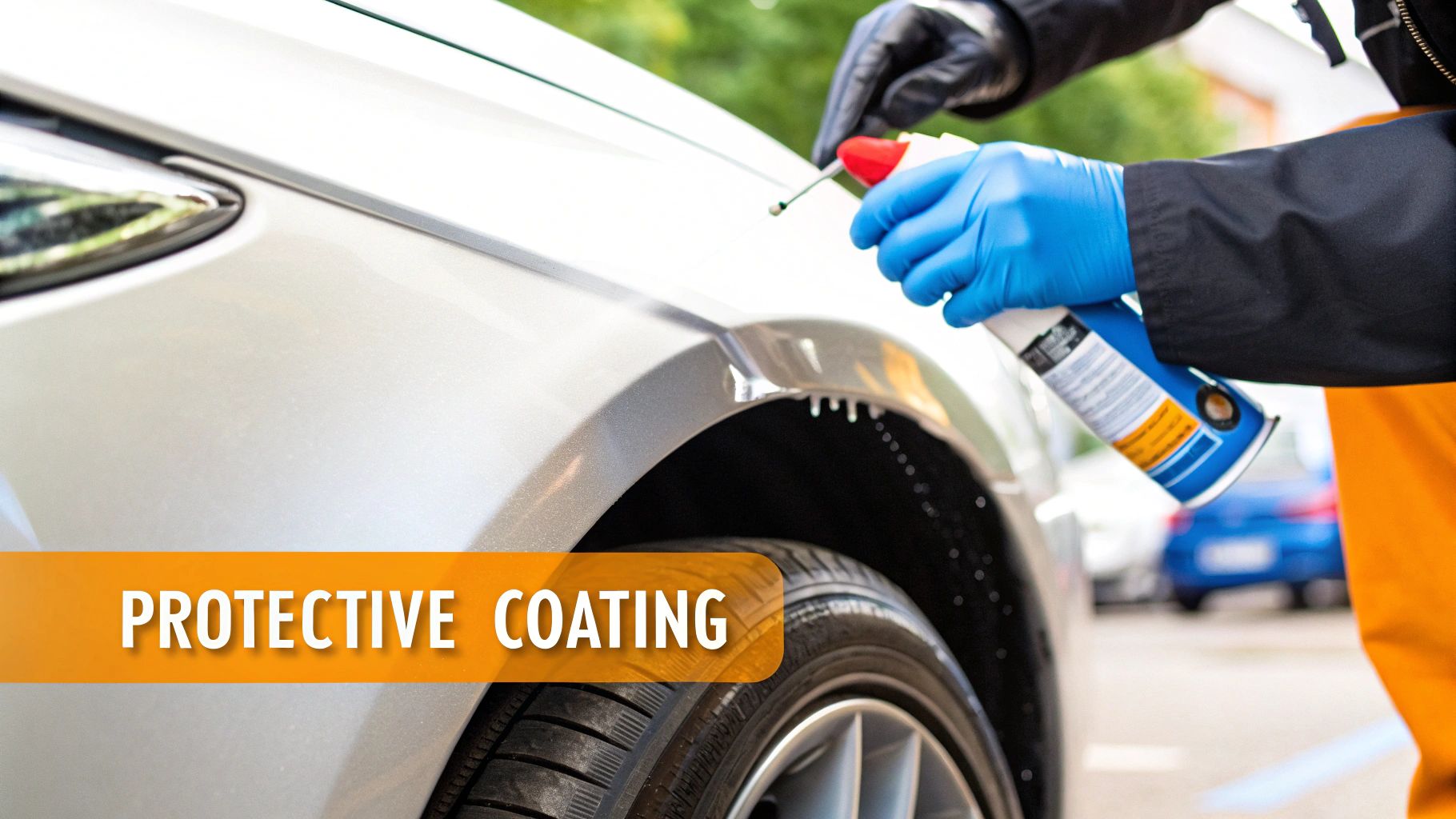
Not all professional car washes are created equal when it comes to preventing water spots. This section will guide you through the range of services available, from standard washes to high-end detailing. We’ll explore what to look for and the right questions to ask to ensure a truly spot-free shine.
Decoding Car Wash Packages: Beyond the Basics
Understanding the differences between car wash packages is the first step. A basic wash may remove surface dirt, but often misses the key components of spot prevention. Look for packages that include spot-free rinsing and drying. This typically involves a dedicated drying process using microfiber towels and possibly a drying aid.
Also, consider the water filtration system employed by the car wash. A facility using filtered or deionized water is significantly less likely to leave spots compared to one using regular tap water. These seemingly small details, often hidden in the fine print, can make a substantial difference in achieving a spotless car.
Asking the Right Questions: Empowering Your Choices
Don’t hesitate to ask specific questions before choosing a service. Inquire about their water filtration process, the types of drying techniques they employ, and whether they use drying aids. A reputable car wash will happily answer these questions. This ensures your expectations are met and you’re receiving the service you’re paying for.
Mobile Detailing and Ceramic Coatings: Evaluating the Options
Mobile detailing and ceramic coatings offer premium spot prevention. However, assessing the quality of these services is crucial. For mobile detailers, inquire about their water source and drying methods. Do they bring their own filtered water? Are their drying techniques effective? For ceramic coatings, research the specific product used and its expected lifespan. A high-quality ceramic coating should offer several months of hydrophobic protection, effectively minimizing water spots.
The Value of Premium Services: Long-Term Benefits
While premium packages or add-on services might seem more expensive upfront, they often offer better value in the long run. Preventing water spots reduces the need for expensive paint correction later, preserving your car’s finish and overall value. This means investing in a higher-quality wash now can save you both money and headaches down the road.
The car wash industry is constantly evolving, driven by consumer demand and technological advancements. In 2025, the global car wash market reached USD 35.39 billion, a 5.8% increase from the previous year. This growth highlights the increasing focus on car maintenance and the adoption of new technologies. You can learn more about the car wash market here. This ongoing evolution underscores the importance of finding professional services that prioritize a water spot-free car wash, a hallmark of quality service. By understanding what makes a truly spot-free wash, you can make informed decisions that protect your vehicle’s appearance and maintain its value.
Rescuing Your Vehicle From Existing Water Spots
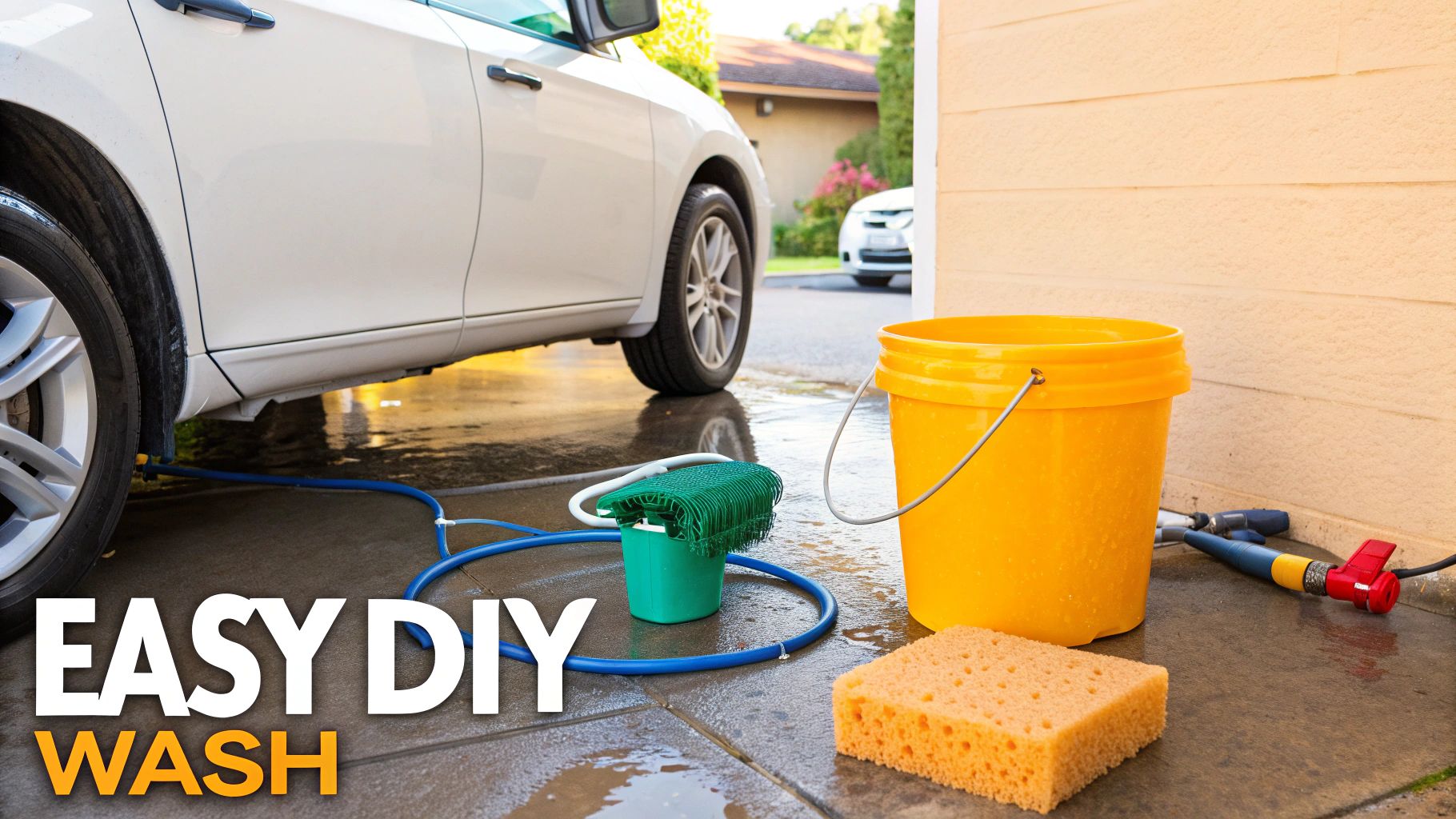
Even with the best preventative measures, water spots can still sometimes appear. This section offers a guide to removing existing water spots, from light mineral deposits to more stubborn etched marks. Understanding the severity is the first step toward effective removal.
Assessing The Damage: Spot Severity And Your Car's Finish
Water spots vary in severity. Fresh water spots often look like light, hazy marks, easily removed with a quick detailer or vinegar solution. These are surface-level and haven't etched into the paint. Etched water spots, however, are more serious.
They appear as more defined, ring-like marks requiring more intensive treatment. Ignoring these can lead to permanent paint damage. The car's finish also influences the removal process.
A standard clear coat finish is relatively resilient but requires careful treatment to avoid scratching. Matte finishes are more delicate and need specialized products to prevent damage during cleaning. Identifying both the spot severity and your car's finish is crucial for choosing the right removal method.
To help you choose the best method for your situation, consult the table below:
Understanding these distinctions will guide you toward the most appropriate and effective removal method. This ensures the best possible outcome while minimizing the risk of damage to your car’s finish.
| Spot Type | Severity | Recommended Products | Application Method | Required Tools | Expected Results |
|---|---|---|---|---|---|
| Fresh Water Spots | Light | Quick Detailer, Vinegar Solution (50/50 with distilled water) | Spray on, dwell, rinse, dry | Microfiber Towel | Complete removal of spots |
| Mineral Deposits | Moderate | Dedicated Water Spot Remover | Follow product instructions | Microfiber Towel, Applicator Pad | Significant reduction or complete removal of spots |
| Etched Water Spots | Severe | Professional Paint Correction/Polishing Compounds | Professional application recommended | Professional polishing tools | Removal of etched spots, restoration of clear coat |
This table provides a general guideline. Always test any product on a small, inconspicuous area first to ensure compatibility with your car’s paint. For serious or etched spots, professional help is recommended.
Removal Techniques: From DIY To Professional Solutions
For fresh water spots on a standard clear coat, a vinegar solution (50/50 mix with distilled water) can be effective. Spray the solution onto the affected area, let it sit for a few minutes, then rinse and dry thoroughly.
This mild acidity helps dissolve mineral deposits. For more persistent spots, a dedicated water spot remover can be used. These are formulated to break down minerals without harming the paint. Deeply etched spots often require professional intervention.
Techniques like paint correction or polishing may be necessary to restore the finish. This involves carefully removing a thin layer of the clear coat to eliminate the etched spots. If you are considering changing your car's color, online tools like Car Color Change Online can help visualize the change.
While DIY methods work for light spots, professional help ensures the correct procedure for serious cases, preserving your car’s paint.
Safe Removal Practices: Protecting Your Car's Finish
Regardless of the method, certain safety protocols are essential. Always work in the shade to prevent rapid drying and streaking. Before applying any product, test it on a small, hidden area to check for compatibility.
When using a water spot remover, follow the product instructions carefully. Resources like How to master a water spot free car wash offer further insights. After removal, rinse and dry thoroughly using a clean microfiber towel.
Proper technique is key to minimizing scratches or further damage.
Specialized Approaches: Glass, Chrome, and Matte Finishes
Different surfaces require different approaches. Glass can be cleaned with dedicated glass cleaners or a vinegar solution. Chrome needs a non-abrasive chrome polish to remove spots and restore shine.
Matte finishes are the most sensitive and require pH-neutral cleaners designed for matte paint. Using the wrong product can damage these finishes, so choose carefully based on the surface. By understanding the nature of your water spots and following these guidelines, you can effectively remove blemishes and restore your car’s finish.
When in doubt, consult a professional detailer, especially for stubborn or etched spots. This ensures effective spot removal without damaging your car's paint.
Creating Long-Term Protection Against Future Spots
After mastering a perfect water spot-free car wash technique, the next step is ensuring long-term protection. This involves understanding effective protective measures, helping you avoid wasting money on ineffective products. This section explores modern paint protection options and how they bolster your car's resistance to water spots.
Hydrophobic Protection: The Science of Water Repellency
Modern paint protection methods, like ceramic coatings and graphene treatments, create a hydrophobic layer on your car's surface. Hydrophobic materials repel water, causing it to bead and roll off rather than spread and evaporate. Think of a freshly waxed car—water beads on the surface. This beading action minimizes the contact time between water and your car's paint, significantly reducing water spots.
Longevity and Maintenance: Extending the Life of Your Protection
While these protective coatings offer excellent water repellency, their longevity varies. Ceramic coatings generally last for one to two years, while graphene treatments can offer longer protection, sometimes up to five years. However, proper maintenance is crucial for maximizing their lifespan. Regular washing with a pH-neutral car wash soap and avoiding harsh chemicals will help maintain the coating's integrity. You might be interested in: How to master a water spot free car wash. Periodic reapplication of a sealant or booster product can also extend the coating’s hydrophobic properties.
Environmental Strategies: Minimizing Spot Risk Between Washes
Even with protective coatings, environmental factors can contribute to water spots. Parking your car in a garage or covered area minimizes exposure to rain and sprinkler water. If covered parking isn't available, consider a car cover, especially during high humidity or expected rain. This provides an extra layer of defense, maintaining a spot-free finish.
Specialized Protection for Challenging Conditions
For those facing especially harsh conditions like hard water or constant environmental exposure, more specialized strategies are needed. Using a deionized water rinse after washing can significantly reduce mineral deposits, even in areas with very hard water. This added step provides extra assurance, particularly beneficial for those seeking a consistently flawless finish. Regularly applying a drying aid or quick detailer can boost the hydrophobic properties of your existing protection, providing an additional barrier against spotting.
These advanced techniques, adapted from professional detailing, help maintain a consistently spot-free finish regardless of the challenges. They offer a comprehensive approach to maintaining a flawless shine.
Ready to experience the ultimate in water spot-free car washing? The SwiftJet Car Wash Foam Gun makes achieving a professional-level clean at home easier than ever. Its powerful foam generation lifts dirt and grime, minimizing scratching, while its convenient design simplifies the entire washing process. Check it out today at SwiftJetUSA.com!
